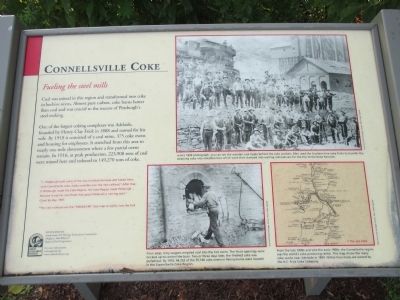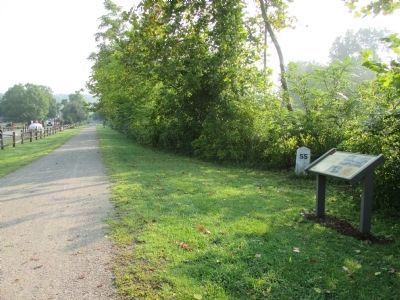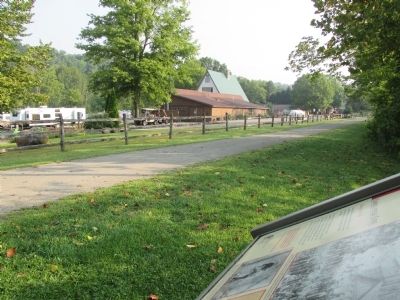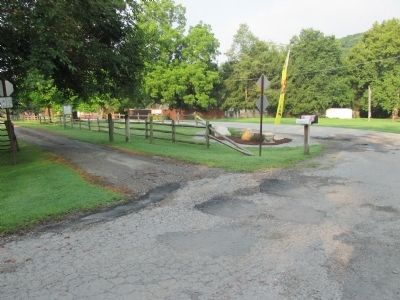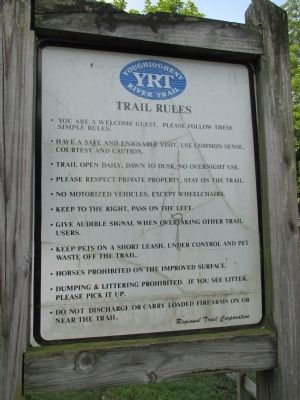Dunbar in Fayette County, Pennsylvania — The American Northeast (Mid-Atlantic)
Connellsville Coke
Fueling the steel mills
Coal was mined in this region and transformed into coke in beehive ovens. Almost pure carbon, coke burns hotter than coal and was crucial to the success of Pittsburgh's steel making.
One of the largest coking complexes was Adelaide, founded by Henry Clay Frick in 1888 and named for his wife. By 1910 it consisted of a coal mine, 375 coke ovens and housing for employees. It stretched from this area to nearly one mile downstream where a few partial ovens remain. In 1916, at peak production, 223,908 tons of coal were mined here and reduced to 149,270 tons of coke.
"...Pittsburgh built some of the new hot-blast furnaces and fueled them with Connelsville coke, easily available over the new railroad.* After that, if Pittsburgh made the Coke Region, the Coke Region made Pittsburgh because it was her coal fields that gave Pittsburgh a running start." Cloud by Day, 1947.
* The new railroad was the: "P.McK & Y. RR" (see map at right), now the trail.
In this 1899 photograph, you can see the wooden coal tipple behind the coke workers. Men used the fourteen-tine coke forks to transfer the steaming coke into wheelbarrows which were then dumped into waiting railroad car for the trip to the blast furnaces. Coal and Coke Heritage Center, Penn State Fayette.
From atop, lorry wagons emptied coal into the hot ovens. The front openings were bricked up to control the burn. Two or three days later, the finished coke was pulled out. By 1910, 44,252 of the 55,166 coke ovens in Pennsylvania were located in the Connellsville Coke Region. Coal and Coke Heritage Center, Penn State Fayette.
From the late 1800s and into the early 1900s, the Connellsville region was the world's coke producing center. This map shows the many coke works near Adelaide in 1899. Notice how many are owned by the H.C. Frick Coke Company. Coal and Coke Heritage Center, Penn State Fayette.
Great Allegheny Passage. For more information: www.gaptrail.org , www.coalandcokepsu.org [sic].
Erected by Southwestern PA Heritage Preservation Commission, Allegheny Trail Alliance, Regional Trail Corporation.
Topics. This historical marker is listed in these topic lists: Industry & Commerce • Railroads & Streetcars. A significant historical year for this entry is 1888.
Location. 40° 2.447′ N, 79° 37.569′ W. Marker is in Dunbar, Pennsylvania, in Fayette County. Marker can be reached from the intersection of Great Allegheny Passage (North). Marker is on the Great Allegheny Passage (north) trail, Youghiogheny River Trail section, next to River's Edge KOA Campground, address 1101 Riveredge Rd., Connellsville, PA. Marker
is in Dunbar township. Touch for map. Marker is in this post office area: Connellsville PA 15425, United States of America. Touch for directions.
Other nearby markers. At least 8 other markers are within 2 miles of this marker, measured as the crow flies. The Remains of the Beehive Coke Ovens (approx. 0.8 miles away); Veterans Memorial (approx. 1.6 miles away); World War I Memorial (approx. 1.6 miles away); World War II Memorial (approx. 1.6 miles away); Chestnut Ridge (approx. 1.8 miles away); Connellsville (approx. 1.8 miles away); a different marker also named Connellsville (approx. 1.8 miles away); For God and Country (approx. 1.8 miles away).
More about this marker. This section of trail was created from the roadbed of the abandoned Pittsburgh, McKeesport and Youghiogheny Railroad, later part of the Pittsburgh and Lake Erie Railroad. The marker is next to old railroad milepost 55, not to be confused with the trail mileposts which are numbered in the low 90's in this area. There is no public parking at the trail access next to the campground, however there is registered parking at the campground.
Also see . . .
1. River's Edge KOA Camp - bike trail information. (Submitted on August 31, 2014, by Anton Schwarzmueller of Wilson, New York.)
2. Great Allegheny Passage. Website homepage
(Submitted on August 31, 2014, by Anton Schwarzmueller of Wilson, New York.)
3. The Coke and Coal Heritage Center. Penn State Fayette website entry (Submitted on August 31, 2014, by Anton Schwarzmueller of Wilson, New York.)
4. Yough River Trail Council. (Submitted on August 31, 2014, by Anton Schwarzmueller of Wilson, New York.)
Credits. This page was last revised on July 3, 2022. It was originally submitted on August 31, 2014, by Anton Schwarzmueller of Wilson, New York. This page has been viewed 909 times since then and 87 times this year. Photos: 1, 2, 3, 4, 5. submitted on August 31, 2014, by Anton Schwarzmueller of Wilson, New York. • Bill Pfingsten was the editor who published this page.
